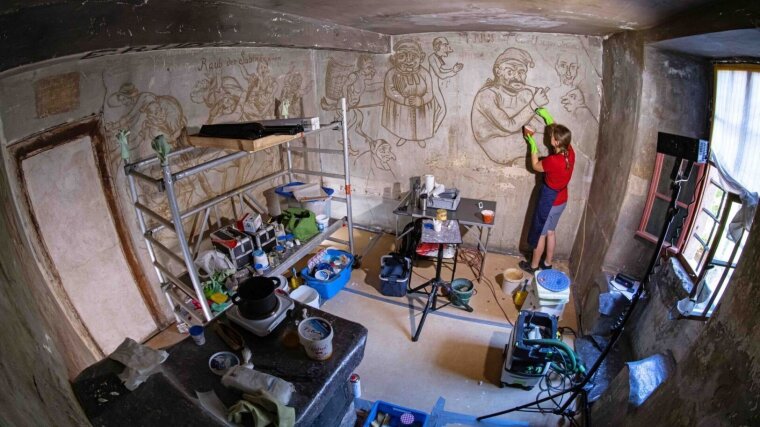
200 years after being painted, the former detention cell at the University of Jena – the Karzer – has been restored to its former »glory«. Over the course of the restoration work, it turned out that its history has to be rewritten.
By Axel Burchardt
200 years ago, in July 1822, one of the nine detention cells for students at the University of Jena is said to have been »decorated« in just one day. The story goes that the Swiss student Martin Disteli was serving time in detention when he decided to use blood, excrement and other organic materials to paint numerous scenes and caricatures on the walls of the approximately 15-square-metre cell. As intriguing as this story may sound, it is merely a legend, as clearly demonstrated by the restoration of the historical detention cell 200 years on.
The only historical student detention cell in Thuringia
The former student prison, built in 1738 and used until the mid-19th century, is located in the building that adjoins the university's old Senate building and that now houses parts of the Institute of Anatomy. The cell window looks out onto the former monastery grounds (»Kollegienhof«). For many years, the detention cell was only opened to visitors on special occasions for fear that the rare paintings might be damaged by wandering hands or perspiration. »It's the only historical student detention cell in Germany that was completely painted by a single artist,« says Dr Babett Forster, Head of the University's Custody.
As she and her colleague Gina Grond were keen to make this historical gem more accessible to the public, they set about restoring the cell using methods that would ensure suitable protection for the paintings. Once the Custody had obtained the necessary funding from the Thuringian State Office for the Preservation of Monuments and Archaeology, as well as the Association for City and University History in Jena and the Friends and Patrons of the Friedrich Schiller University Jena, the restoration project could begin.
The work was assigned to Katharina Heiling, a restorer specializing in student detention cells. Before the practical phase of the project could begin in Jena, she sent some material samples from the detention cell to a special laboratory in Prague. The analysis proved that neither blood nor excrement had been used for the artwork, but rather paints that were common 200 years ago. Disteli is thought to have made the colours himself from yellow and brown ochre (naturally occurring earth pigments), using linseed oil and lime casein as binding agents. The first part of the legend had been debunked.
The tale that Disteli had decorated the detention cell as a prisoner in a matter of hours was also consigned to the realms of mythology by Katharina Heiling. The restorer cleaned the surface to gain an unimpeded view of the paintings, allowing her to prove that Disteli had not used a rapid fresco technique on wet lime plaster, but instead employed a secco technique on plaster that had already dried.
Artwork not created »in detention«
It is striking to note that different binding agents have been used on the various walls, which makes the paintings on the north wall differ greatly from the others. Forster says that her team now assumes that Martin Disteli was not serving time in detention when he decorated the room, but was merely visiting the cell and took the opportunity to paint its previously blank walls. The date, 30 July 1822, probably refers to when the work was completed.
The work of the Swiss painter and political cartoonist Martin Disteli is a work of art that should be preserved. Restorer Heiling stabilized the walls and paint, cleaned the paintings and touched up missing areas. »Any marks evidencing the use of the detention cell will not be restored,« she says. A particular challenge was a find Heiling made when examining the fourth, apparently single-coloured wall with UV radiation. The short-wave radiation can cause a work of art to fluoresce, thus enabling a more differentiated perception of the painting materials used. As a result of her investigation, she has proven that other paintings are hiding behind the layers of paint that were added at a later date. »The wall was painted over later,« asserts Heiling.
Here Katharina Heiling talks about her work in the detention cell in this video
placeholder image — Stylized representation of a film projector
Graphic: Freepik